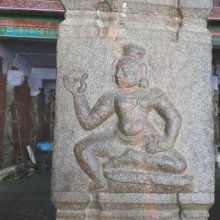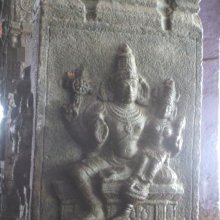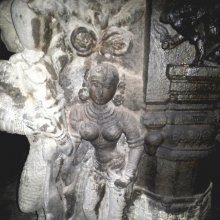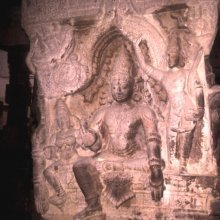Sandamsha, Sandaṃśa: 6 definitions
Introduction:
Sandamsha means something in Hinduism, Sanskrit. If you want to know the exact meaning, history, etymology or English translation of this term then check out the descriptions on this page. Add your comment or reference to a book if you want to contribute to this summary article.
The Sanskrit term Sandaṃśa can be transliterated into English as Sandamsa or Sandamsha, using the IAST transliteration scheme (?).
Images (photo gallery)
(+6 more images available)
In Hinduism
Natyashastra (theatrics and dramaturgy)
Source: Wisdom Library: Nāṭya-śāstraSandaṃśa (सन्दंश) refers to a gesture (āṅgika) made with a ‘single hand’ (asaṃyuta), according to the Nāṭyaśāstra chapter 8. The hands (hasta) form a part of the human body which represents one of the six major limbs (aṅga) used in dramatic performance. With these limbs are made the various gestures (āṅgika), which form a part of the histrionic representation (abhinaya).
Source: archive.org: Natya ShastraSandaṃśa (सन्दंश, “pincers”).—A type of gesture (āṅgika) made with a single hand (asaṃyuta-hasta);—(Instructions): The forefinger and the thumb of the Arāla hand crossed and the palm a little hollowed. The Sandaṃśa (hand) according to the Sentiments and States, is of three kinds, viz. that [held] in front, that near the mouth and that on one side.
(Uses): In representing the plucking of flowers, taking up grass, leaves, hairs or thread and holding or pulling out an arrow or thorn the Sandaṃśa should be held in one’s front. And to represent taking off a flower from its stem, the wick [of a lamp], [collyrium] stick, etc. filling up [any vessel with any thing], in saying ‘fie [upon you]’, in anger, this should be held near the mouth.
Source: Shodhganga: Elements of Art and Architecture in the Trtiyakhanda of the Visnudharmottarapurana (natya)Sandaṃśa (सन्दंश) refers to one of the twenty-two Asaṃyuktahastas or “single hand gestures” (in Indian Dramas), according to the Viṣṇudharmottarapurāṇa, an ancient Sanskrit text which (being encyclopedic in nature) deals with a variety of cultural topics such as arts, architecture, music, grammar and astronomy.—The hasta-mudrās (lit. “hand-gestures”) are very essential to denote some particular action or state in dancing and these mudrās are formed with the help of hands and fingers.—The word sandaṃśa means kaṅkamukha i.e., a pair of tong. Tong is a kind of tool which is used to hold something. According to the Viṣṇudharmottarapurāṇa, when the tip of the forefinger and the thumb are pressed together like the mouth of a tong and the middle portion of the palm is curved in arāla-hasta, this posture is called sandaṃśa-hasta. This hand posture involves the closing and opening of fingers. The Viṣṇudharmottarapurāṇa speaks of three kinds this form viz., agraja, mukhaja and pārśvakṛta and it gives detailed discussion of the usages of each one clearly. The agraja sandaṃśa-hasta is used for holding and extraction of thorns or splinters. The mukhaja is used to show the activity of plucking flowers. There are many uses of pārśvakṛta type of sandaṃśa-hasta viz., colouring of picture, pressing of breast, showing of head etc.
According to the Abhinayadarpaṇa, sandaṃśa-hasta is used to show the action of offering something to gods. The belly portion is also indicated with this hand posture. Besides, this posture is also used to indicate something like injury, worm, terror as well as number five.

Natyashastra (नाट्यशास्त्र, nāṭyaśāstra) refers to both the ancient Indian tradition (shastra) of performing arts, (natya—theatrics, drama, dance, music), as well as the name of a Sanskrit work dealing with these subjects. It also teaches the rules for composing Dramatic plays (nataka), construction and performance of Theater, and Poetic works (kavya).
Purana and Itihasa (epic history)
Source: archive.org: Puranic EncyclopediaSandaṃśa (सन्दंश).—A hell. (See under Kāla).

The Purana (पुराण, purāṇas) refers to Sanskrit literature preserving ancient India’s vast cultural history, including historical legends, religious ceremonies, various arts and sciences. The eighteen mahapuranas total over 400,000 shlokas (metrical couplets) and date to at least several centuries BCE.
Languages of India and abroad
Sanskrit dictionary
Source: Cologne Digital Sanskrit Dictionaries: Shabda-Sagara Sanskrit-English DictionarySandaṃśa (सन्दंश).—m.
(-śaḥ) 1. A pair of tongs or nippers. 2. The great compression of the teeth in the pronunciation of vowels. E. sam with, daṃśa biting.
Source: Cologne Digital Sanskrit Dictionaries: Yates Sanskrit-English DictionarySandaṃśa (सन्दंश):—[sa-ndaṃśa] (śaḥ) 1. m. A pair of tongs or nippers; a hell.
Sanskrit, also spelled संस्कृतम् (saṃskṛtam), is an ancient language of India commonly seen as the grandmother of the Indo-European language family (even English!). Closely allied with Prakrit and Pali, Sanskrit is more exhaustive in both grammar and terms and has the most extensive collection of literature in the world, greatly surpassing its sister-languages Greek and Latin.
See also (Relevant definitions)
Starts with: Sandamshahasta, Sandamshaka, Saṃdaṃśa.
Ends with: Saṃdaṃśa.
Full-text: Mukhaja, Agraja, Parshvakrita, Kankamukha, Plucking, Thorn, Splinter, Extraction, Colouring, Tong, Pressing, Showing, Asamyuta, Avici, Andhakasura.
Relevant text
Search found 13 books and stories containing Sandamsha, Sandaṃśa, Sandamsa, Sa-ndamsha, Sa-ndaṃśa, Sa-ndamsa; (plurals include: Sandamshas, Sandaṃśas, Sandamsas, ndamshas, ndaṃśas, ndamsas). You can also click to the full overview containing English textual excerpts. Below are direct links for the most relevant articles:
The Shiva Purana (by J. L. Shastri)
Chapter 16 - Uplift from the hell < [Section 5 - Umā-Saṃhitā]
Vishnudharmottara Purana (Art and Architecture) (by Bhagyashree Sarma)
2.2. Hand Postures (a): Asaṃyukta-hasta < [Chapter 3 - Drama and Dance]
The Skanda Purana (by G. V. Tagare)
Chapter 12 - The Greatness of Svāmipuṣkariṇī: Redemption from Hells < [Section 1 - Veṅkaṭācala-māhātmya]
Chapter 29 - The Great Efficacy of Anaraka Tīrtha < [Section 1 - Avantīkṣetra-māhātmya]
Chapter 30 - The Glory of Dhanuṣkoṭi < [Section 1 - Setu-māhātmya]
Shishupala-vadha (Study) (by Shila Chakraborty)
Citrakāvya (1): Yamaka < [Introduction]
Natyashastra (English) (by Bharata-muni)
The Brahma Purana (by G. P. Bhatt)





